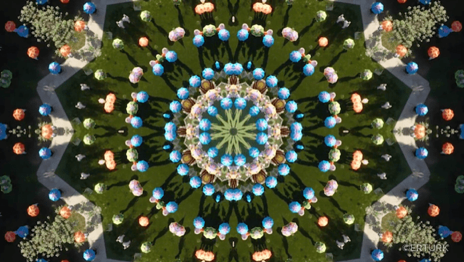
ELIZABETH TURK, ET PROJECTS, “Video footage of Look Up,” 2021, Scripps College.
A dream, a seed, a larger picture…
What does it look like to be an artist? Incipit Vita Artis (Thus Begins a Life of Art) invites you into the art worlds of three contemporary alumnae artists— Susan Hertel ’52, Alison Saar ’78, and Elizabeth Turk ’83. While each artist has her own distinct style and voice, they are remarkably similar in their interdisciplinary approaches and authentic interpretations of life. Hertel, Saar, and Turk explore the social, political, and personal environments that surround them. They do not limit themselves when it comes to concept, material or medium. The 18 works in this exhibition—including paintings, prints, poems, and sculptures—showcase that for these women, art is more a way of life than a profession.
Susan Hertel’s canvases capture the people, animals, and landscapes that she loved. Her environmental activism seems only natural when one views her artwork and poetry. Alison Saar’s sculpture, prints, and poetic collaboration bring resilience and strength to Black figures. Elizabeth Turk’s sculptures seemingly make the impossible possible, and her immersive art experiences bring communities together. Each of these artists ask questions that dig below surface level knowledge, and rather than providing answers, room is left for viewer interpretation.
Hertel, Saar, and Turk were greatly influenced by their humanities studies at Scripps and have made work that is as multifaceted and discourse-prompting as a liberal arts education. Hertel once said that her time in undergrad was full of a sense of possibility, a dream and a “reminder of the universe’s generosity.” Saar shared that during her time at Scripps, “a seed was planted” that grew her fascination with many of the themes she explores in her art today. Turk stated that Scripps “strengthened my generalist viewpoint, teaching my fingertips the patience to find and develop the larger picture.” After graduating, each pursued their craft, achieved success during their lifetimes, and made a positive impact on the world. These alumnae artists, together with all Scripps students, share a new beginning, an origin story that is Incipit Vita Nova, here begins new life.
Vivian Monteiro (SC ’23), Getty Curatorial Intern, Summer 2021

SUSAN HERTEL, “Horses: Town and Country, Houston, TX (Memorial Branch – Mural Study),” c. 1984, Scripps College
My ideal in painting, is that moment when what’s every day is seen as magical… To me, that’s what a painting can do, if it wants to, when it works (or music or any of the other arts). It can take that magical complexity and lead it into an inevitable, unquestionable simplicity and array the spirit. That’s what I’m working towards…
Susan Hertel was a painter, muralist, and poet who spent her life on ranches in Glendora, California, and Cerillos, New Mexico. With thin expressive strokes of oil paint, Hertel captured quiet moments of life, exuding their hidden beauty. She painted her animals—horses, dogs, and Nubian goats—with affection and empathy, giving them equal importance to her human figures.
Hertel enrolled at Scripps College in 1948, where she studied studio art. She was most influenced by Millard Sheets, chairman of the Scripps art department and a nationally recognized artist, and Henry Lee McFee, a pioneering cubist painter. Sheets spurred her interest in public art and McFee greatly impacted her attitude toward painting, teaching her to paint human and animal figures as if they were still lifes. She worked on her art with an intensity and focus her peers admired. Of her time at Scripps, Hertel stated that “[m]y favorite dreams are about houses in which I discover new rooms or whole new wings. What makes them so satisfying is the sense of possibilities, of new beauty and width, the reminder of the universe’s generosity. Scripps was, for me, one of these dreams. For me, it really was the beginning of a new life.”
After graduating, Hertel worked for Millard Sheets. She executed many mural designs as a member of his studio. She would go on to collaborate with the Millard Sheets Studio for twenty-six years, helping to produce over eighty murals throughout the United States. Hertel was also involved in social and environmental activism, and after moving to New Mexico she participated in citizen’s committees aimed at preserving the desert’s ecology and protecting it from large-scale gold mining.
Paintings would always be Susan Hertel’s focus. They were autobiographical, and never separate from her day-to-day life. In them we see her world through her own eyes, which captures forever the dogs, horses, goats, and children that she loved. As former Williamson Gallery Director Mary MacNaughton noted in Susan Hertel, a Retrospective, “She wove together her art and life, which she saw in spiritual terms as unified.”
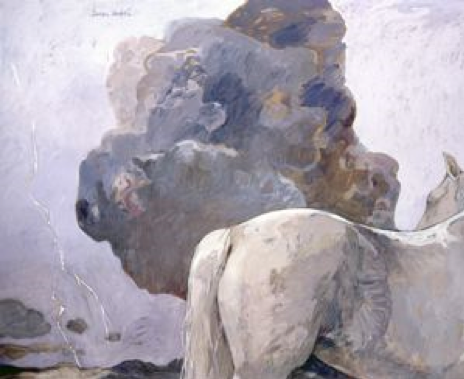
SUSAN HERTEL (1930-1993)
Mare and Clouds, 1988
Oil on Canvas
50 in. x 60 in.
Scripps College, Gift of Ms. Sarah Schmerl
2002.2.1
A storm is brewing as a white horse watches a bolt of lightning strike the horizon. It is likely Hertel’s own horse, Saro, who appears in many of her paintings. She depicts the horse actively observing the surrounding environment, the composition an example of how Hertel tried to “keep away from …the usual way of looking at horses,” and that for her, “[h]eads are not the focus… they stop the eye. I want that rhythm that happens from shape to shape to be…flowing.”
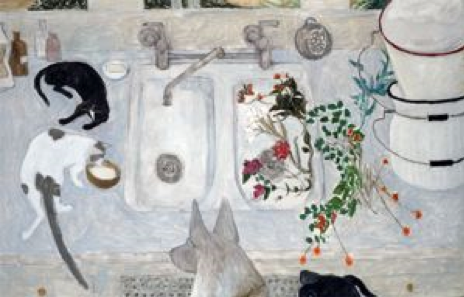
SUSAN HERTEL (1930-1993)
Cats on the Sink, 1975
Oil on Canvas
40 in. x 62 in.
Scripps College, Gift of James Strombotne
81.7.1
Hertel had the ability to find beauty in everyday moments. In this painting, two cats lounge on a kitchen counter while two dogs look on, eyeing their bowl of milk. The muted tones of the kitchen are interrupted by the vibrantly colored flowers that have been left around the sink.
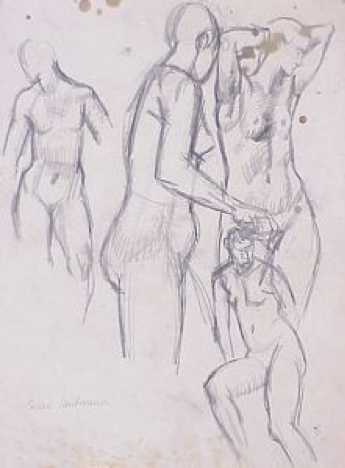
SUSAN HERTEL (1930-1993)
Untitled (Nudes)
Ink on Paper
23 7/8 in. x 18 7/8 in.
Scripps College, Gift of Susan Lautmann Hertel
1941
This sketch was possibly made during or around the artist’s time at Scripps, given she has signed with her maiden name, Lautmann, and the nudes look like they could have been made in a figure drawing class.
As a student, Hertel participated in weekly drawing sessions with a hired model, in a studio on the north side of Seal Pond.

SUSAN HERTEL (1930-1993)
Horses: Town and Country, Houston, TX (Memorial Branch – Mural Study), c. 1984
Gouache and Pencil on Paper
27 5/16 in. x 4 3/16 in.
Scripps College, Gift of Washington Mutual Bank, 1999
99.3.20
After graduation from Scripps, Hertel worked for the Millard Sheets Studio. She contributed to over eighty mural designs for various Home Savings of America bank branches, which would often start as small gouache paintings like this one.
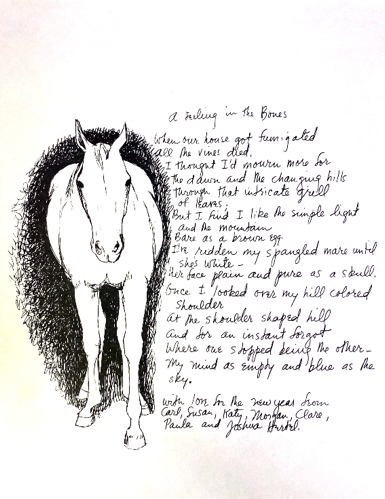
SUSAN HERTEL (1930-1993)
A Feeling in the Bones
Ink on Paper
8 1/2 in. x 11 in.
Ink on paper
Scripps College, Denison Library Archives
This poem is a reflection on the sense of belonging Hertel felt with the natural landscape.
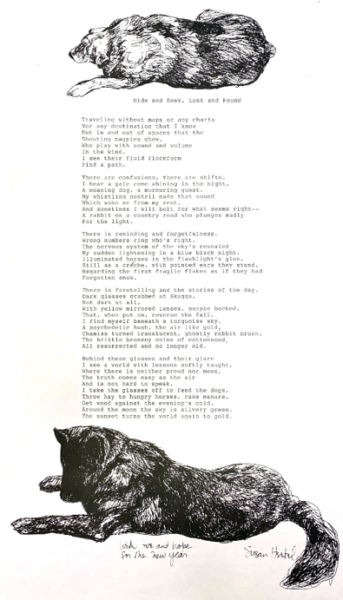
SUSAN HERTEL (1930-1993)
Hide and Seek, Lost and Found
Ink on Paper
8 ½ x 16 in.
Ink on paper
Scripps College, Denison Library Archives
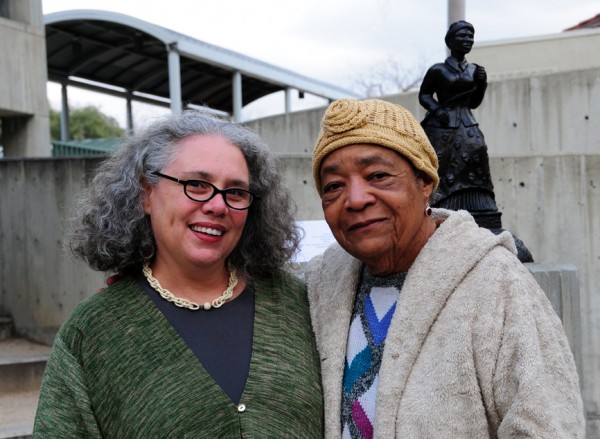
Alison Saar (left) and Professor Emerita Dr. Samella Lewis (right) in front of Saar’s sculpture “Swing Low, Harriet Tubman Memorial,” 2010.
I wanted to make art that told a story, that would engage people. I wanted them to be moved by my work, whether it was specifically what my intentions were or not did not matter. I wanted them to be drawn in and affected by my sculpture.
Alison Saar is an artist who creates prints and sculptures, often incorporating found objects that add life and history to her art. Through the use of materials like recycled ceiling tin, sugar sacks, and handkerchiefs, Saar’s art is an extension of, as well as a reaction to, the histories she examines. She explores themes of race, gender, and narrative, with a focus on Black womanhood.
Saar grew up in an artistic environment, raised by influential collagist and assemblage artist Betye Saar and painter and art conservator Richard Saar. She attended Scripps College from 1974—1978, where she pursued a dual degree in art and art history. Here, she was mentored by Dr. Samella Lewis, who has often been called the “Godmother of African American art.” With Dr. Lewis, Saar studied Caribbean and Black folk art. She wrote her senior thesis on works made by self-taught African American artists. Of her time at Scripps, Saar shares: “I’d have to say my most valued tools acquired from Scripps are my writing skills. Through writing, I have been able to verbalize my ideas to others and myself, in a clear and artful manner. I believe that writing, coupled with a strong Humanities background has enriched and broadened my vision of the world.”
At first, Saar had no intention of following in her famous mother’s artistic footsteps, which is why she studied art history. However, she soon discovered she felt more satisfaction from making art than writing about it. After undergrad, Saar received her MFA from the Otis Art Institute at the Parsons School of Design. Saar’s work goes hand in hand with her own identity, as it is in part a reaction to her lived experience. Art critic Leah Ollman ’83 wrote that “the personal, political and poetic converge” in Saar’s sculpture. Saar often collaborates with poets, resulting in work that is both visually and lyrically moving.
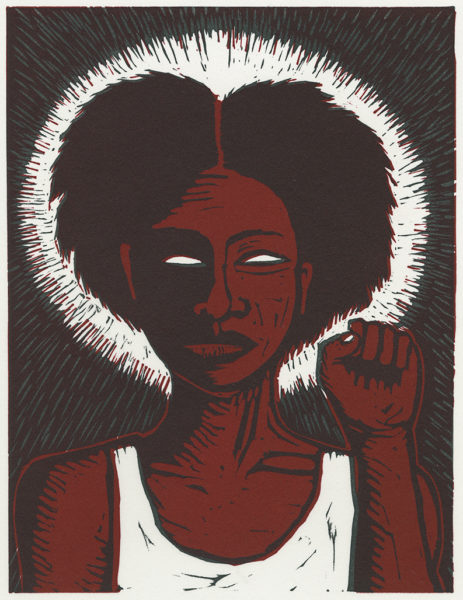
ALISON SAAR (b. 1956)
Rise, 2020
2 pass linoleum on letterpress
8 1/2 x 11 in.
Scripps College, Purchase, Samella Lewis Contemporary Art Collection
2020.4.1
Saar created this print in 2020 to honor the Black Lives Matter movement. To make the central figure, she looked at images of different women from the Black Panther Party, then contemporized the hairstyle “to say we’re still fighting the same battle.” One hundred editions were made and sold, and all proceeds were donated to local Los Angeles community organizations Dignity and Power Now (DPN), Summaeverythang Community Center, and Crenshaw Dairy Mart.
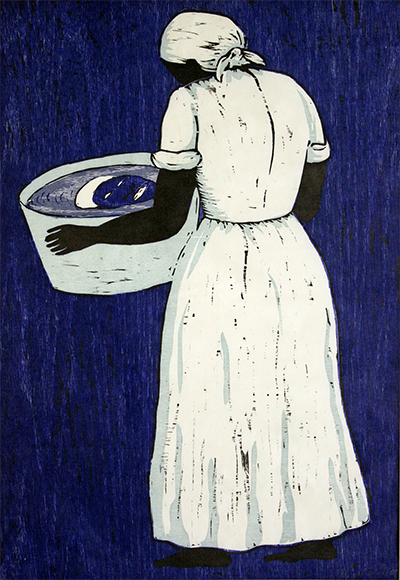
ALISON SAAR (b. 1956)
Washtub Blues, 2000
Ink on Paper
30 in. x 22 in.
Scripps College, Gift of Allison Saar
2007.7.2
A common thread in Saar’s career is the exploration of Black female identity and working women. This print depicts a washer woman looking into her own reflection in a washtub. Her back is to the viewer because many women who perform household labor remain anonymous. Saar explains that “in some ways it’s a tribute to all those who have gotten us to this point of here and now.”
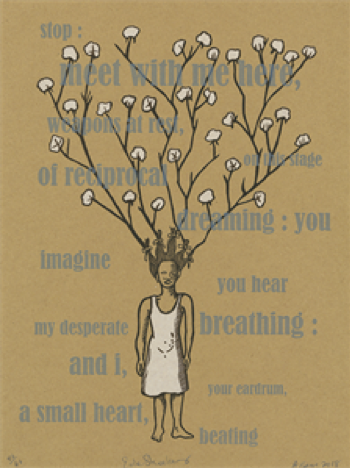
ALISON SAAR (b. 1956) and EVIE SHOCKLEY (b. 1965)
Alison and Evie Broadside, 2018
Linoleum and Letterpress on Craft Crane Paper
16 x 12 in.
Scripps College, Purchase, Samella Lewis Collection of Contemporary Art
2020.4.2
A broadside is a large, one-sided print that has historically been plastered onto walls as a form of advertisement, information, or proclamation. For this broadside, Saar collaborated with the poet and Pulitzer Prize nominee Evie Shockley. The character of Topsy from Harriet Beecher Stowe’s Uncle Tom’s Cabin is depicted, with branches of a cotton tree crowning her head. Shockley’s poem floats around her.
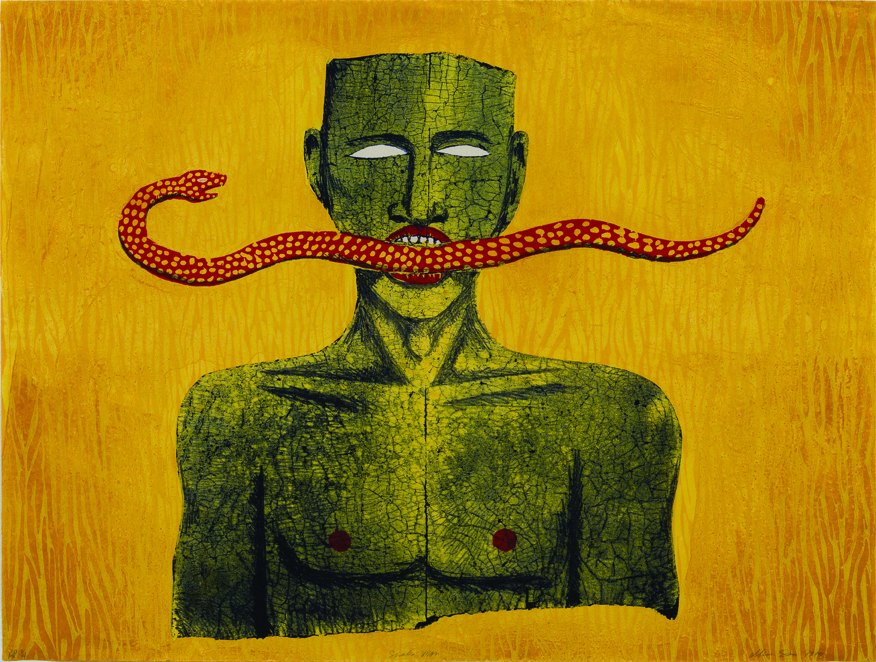
ALISON SAAR (b. 1956)
Snake Man, 1994
Lithography and Woodcut, Ink on paper
28 x 37 in.
Scripps College, Purchase, Scripps Collectors’ Circle
2015.2.17
Before making this piece, Saar came across a sheet of linoleum “all curled up,” and when she straightened it out there were cracks and creases. When printed, these cracks and creases resulted in the reptilian texture of the snake man’s skin. The mouth and snake were like a cutout puzzle piece that was stamped in afterwards.
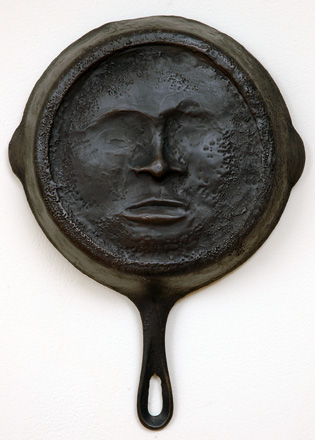
ALISON SAAR (b. 1956)
Mirror, Mirror, 2006
Bronze Sculpture
16 in. x 8 in. x 3 in.
Scripps College, Gift of Alison Saar
2007.7.1
The skillet is a reoccurring object in Alison Saar’s work. It references a history of kitchen labor, in particular the cooking traditions of Black women. This skillet is at once a frying pan and a mirror, reflecting the face of the woman who might have held it.
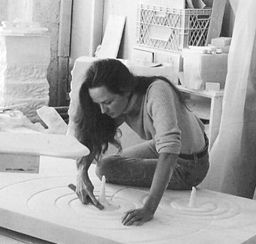
Elizabeth Turk, image courtesy of the artist
I think my sister describes my work best. She says that ‘your work is inspirational because it’s making something possible out of the impossible.’
Elizabeth Turk is an artist known for her marble sculptures that explore the concept of paradox. They are seemingly weightless despite their marble construction, they are a result of both positive and negative space, and they are contemporary objects carved from a material with an ancient history. In 2018 Turk created ET Projects, a non-profit dedicated to creating immersive art experiences that bring people together.
An alumna from the class of ’83, Turk credits Scripps for training her imagination. Although she majored in international relations, she found the humanities education invaluable to her future way of life. “Scripps underscored the value of direct study and refined my tools to contribute to the conversation. Making things is all I do, I love it; sculpture, drawings, poems… Objects can be decidedly ‘uncool’ for a contemporary artist, but Scripps strengthened my generalist viewpoint, teaching my fingertips the patience to find and develop the larger picture.” During her time at Scripps, Turk took an introduction to sculpture class with Professor Aldo Casanova. After graduating, when Turk decided to become an artist, Casanova became a mentor to her. She went on to receive her MFA from Maryland Institute College of Art, Rinehart School of Sculpture.
Finding inspiration in the natural world, many of Turk’s sculptures appear as if they belong in nature, bridging the imaginary divide between human creation and our naturally occurring environment. “I hope, when I’m long gone, that’s one of the strongest messages— of just having humans see themselves from inside nature once again. We used to in other times in our history, you know, not [see ourselves] outside or hierarchically with nature, but more of a part of it. I think that’s an ongoing discussion.” Indeed, Turk’s work doesn’t seek to provide answers, but prompts the viewer to ask questions.
In terms of her identity as an artist, Turk states that “there’s not a boundary between who I am and who the art is.” For her, art is not a job or a career. It is a way of life which involves truly seeing our surroundings and engaging with them.
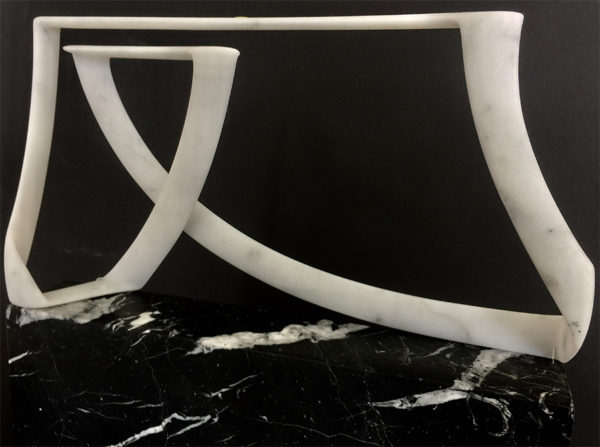
ELIZABETH TURK (b. 1961)
Cage 13.5, 2013-2015
Marble on Marble
12 x 18 1/4 x 4 in.
Scripps College, Purchase, Scripps Collectors’ Circle
2017.4.7
This sculpture is an excellent example of Turk’s interest in paradox. It is labeled as a cage, and yet it has openings. It is carved from a single block of marble, and yet it has a fluidity in the way it bends that makes us wonder–is it really stone at all?
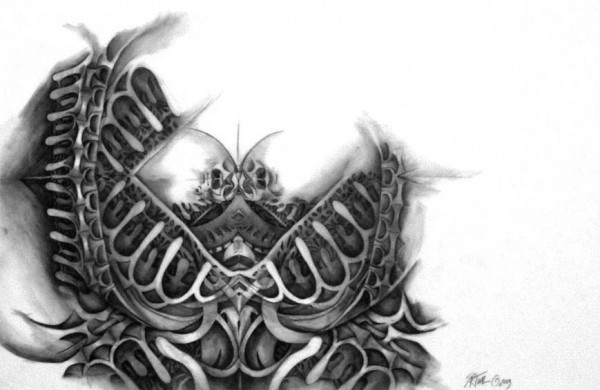
ELIZABETH TURK (b. 1961)
Graphite on Vellum: #5, 2003
Graphite on Vellum
38 in. x 36 in.
Scripps College, Gift of Mr. and Mrs. Robbins
2006.6.3
These intricate graphite drawings are created on vellum, a translucent parchment. They have a physicality that appears almost three dimensional. To make these drawings, Turk created reference images by combining and manipulating multiple forms in photoshop. If you’ve noticed any vertebral or plant-like qualities, that’s why!
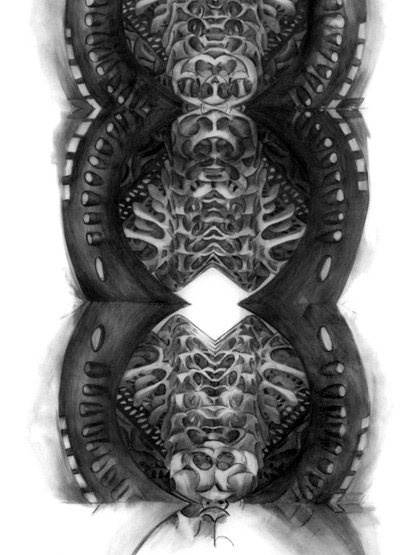
ELIZABETH TURK (b. 1961)
Graphite on Vellum: #4, 2003
Graphite on Vellum
38 in. x 36 in.
2006.6.2
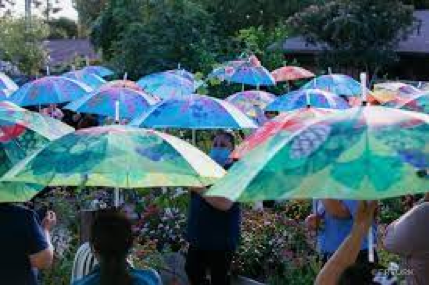
ELIZABETH TURK (b. 1961)
Look Up! Umbrella, 2021
Courtesy of Private Collection
This umbrella was used during ET projects’ “Look Up!” on Scripps campus. The botanical pattern, designed by Turk, is inspired by plants that are known for their ability to thrive in the face of great adversity.

ELIZABETH TURK, ET PROJECTS
Video footage of Look Up
Video screen of any size
Fall semester of 2021, students returned to campus after over a year of virtual learning. Turk recognized this unique situation and designed a Look Up! event that would bring this fragmented community together. The goal was that every participant “would bump into a new friendship,” and that together Scripps students would create a work of art to be proud of. Drone footage of the event was compiled into this kaleidoscopic, entrancing video.

